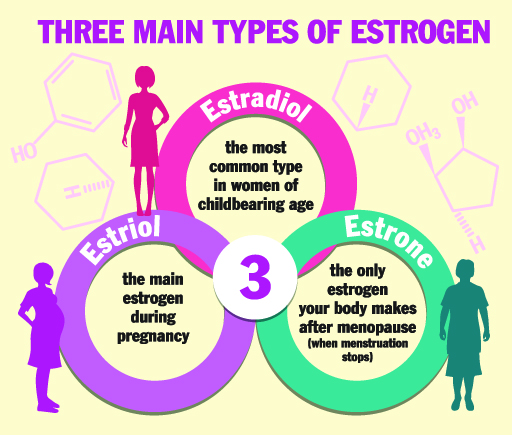7.1 Oestrogen
Menopause is commonly associated with changes in sex hormones, in particular the reduction of oestrogen.
As shown in the following f, oestrogen (also spelt estrogen) is not one hormone but three. Firstly, oestradiol (E2) is the predominant type and is produced in the ovaries. Low levels of this hormone contribute to an increased risk of cardiovascular disease and weight gain. Secondly, oestrone (E1) which is a weaker type of oestrogen predominant in post-menopausal women, and thirdly oestriol (E3), which is produced by the placenta during pregnancy (Burrell et al., 2014).
The ovaries provide the site for the production of most of the body’s oestrogen in pre-menopausal people, but it is also made by fat tissue and in the liver and adrenal glands (Mansberg, 2020). Once oestradiol (E2) production shuts down in menopause, the body continues to produce oestrone (E1). However, this form of oestrogen promotes breast cancer in obese females and, unlike oestradiol, does not have a protective effect on bones, the cardiovascular system and the brain (Burrell et al., 2014).
There are oestrogen receptors all over the body, and thus this hormone influences many body processes, with important roles in cognitive health, including memory and ability to concentrate, mood changes through its role in regulating the feel good chemical serotonin, bone and joint health, the regulation of body temperature, and the function of the cardiovascular system (Mansberg, 2020). During menopause, falling levels of oestrogen are associated with symptoms such as loss of bone density potentially leading to osteoporosis. Also, oestrogen protects cardiovascular health by looking after the heart and circulatory system, so that after menopause, women can become more prone to heart disease.

